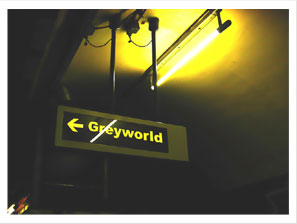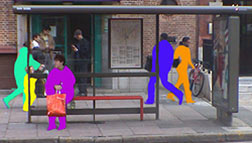Can’t believe how lucky I am! I had lunch today with Andrem Shoban from Greyworld whose work I already knew and admire. Then I discovered the work of Fiona Raby, fascinating, totally fascinating.

So let’s start with Greyworld. Shoban founded Greyworld in 1993 in Paris then 2 year after they were back to London where they still have their studio now.
They do interactive urban art for the “people who buy cans of beans,”not for the elite. Their installations try to involve the public as much as possible in a ludic and surprising way.
In 2002, they created the ColourStops installation for five bus stops in Bradford, UK: In the bus stop shelters, Greyworld concealed colour-recognition cameras that create sounds according to the colours they detect. The work tries to reflect back the variety of differences in people, Bradford being a very multi-ethnic city.

Three years ago, on the Millennium Footbridge in Dublin, they inserted sensors in the carpet covering the bridge, they detect the size of the feets and the speed of your walk, according to these data, different sounds are generated so that you can walk to the sound of music or hear the sound of crunchy leaves or snow or the flop flop of water.
See also The Source that opens and closes the London Stock Exchange since April 2004.
The group is now working on Bins and Benches (flash presentation) to be installed in The Junction (London)
These urban furniture are able to roam free in the Piazza area.
The benches love to be sat on, and they often take up position in new spaces to make themselves more attractive to potential human sitters. Sometimes, when it rains, they move themselves to drier, shadier areas of the square. To attract potential human sitting folk, they like to form patterns – the benches moving in to shapes in the centre of the piazza.
The bins are a little more solitary. It’s a tough life being a bin, and they like to contemplate their humble lot on their own.
When the mood takes them, the surniture like to burst in to song. Sometimes, small clusters gather together and sing a tight six-part harmony, and occasionally, though much more rarely due to their shyness, the bins join in with their sweet soprano voices.
Each bench drifts slowly around the square, no faster than a strolling human, and is equipped with sensors that detect the presence of objects in its immediate vicinity, coming to a complete halt when any object is coming close.
